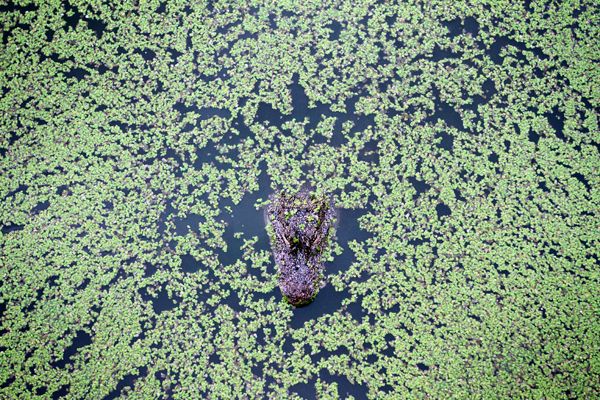This week I travel to the province of Anhui, situated in the Yangtze River basin west of Shanghai. I travel to this region to begin the chapter of my work on the effects of wetland disappearance on animal species in China.
As way of introduction to this chapter, I recently interviewed Joe Abene, a long-time alligator researcher who worked for the Bronx Zoo in New York for many years and is an expert on the Chinese Alligator (Alligator sinensis), a species which is on the brink of extinction in the wild.
This first post serves as an introduction to the plight of the Chinese alligator. Later this week, I travel to the Anhui Research Center of Chinese Alligator Reproduction to report on the work being done there to save the species.
How and when did you originally become involved in the plight of the Chinese Alligator?
My love of Chinese/Yangtze alligators started at the Bronx zoo, where I worked in the reptile house for 15 years. The curator, John Behler, and the previous supervisor, Peter Brazaitis, had already been trail blazers in crocodilian conservation and Chinese alligators were a species they showed special interest in. By the time I started working at the zoo, the staff there had already been instrumental in the first captive breeding of the species in the USA. During my time at the zoo, I participated in the care of a large group of captive Yangtze alligators. Mr. Behler was the Association of Zoos and Aquariums Species Survival Plan coordinator for the species, and when he passed away, I took over the position. Along with managing the captive populations in the US, I started to get involved in fieldwork. I had a strong interest in Chinese history and culture, so working in China was something I had always wanted to do anyway. In 2007, I was invited to a meeting in Shanghai concerning Yangtze alligator conservation. It was decided at the meeting that a thorough survey of the wild population was needed. I returned to China a few months later to conduct the survey with Dr Zhang and officials from the Anhui Research Center of Chinese Alligator Reproduction. We have continued that work since then and I will be back in China in August.
What do you feel are the main causes for the decline in numbers over the past few decades in the lower reaches of the Yangtze River?
In my opinion, although many factors could have contributed to the decline in the wild population of Yangtze alligators, the loss of habitat is by far the most serious. In the past, the alligators were occasionally hunted for food and medicine. Sometimes, they were even killed by farmers, who were just trying to protect their ducks and fish. But since the Chinese government has given the Yangtze alligators the highest level of protection, their biggest obstacle has been finding a place to live.
Currently, what are your biggest concerns regarding the survival of the Chinese Alligator in the wild?
My biggest concern is that the Chinese government will not be able to set aside enough habitat to sustain a large viable population of Yangtze alligators, without harming the livelihoods of the farmers that currently live there. Even though the area of wild Chinese alligator habitat is just a speck on the map of China, there are still many people living there. Hopefully, the Chinese government can figure out a way for the alligators and the farmers to live harmoniously. I am just afraid that the species will not survive in its historical habitat, if the area is not completely protected for the alligators to re-establish themselves.
What are the most encouraging aspects of conservation you have seen?
I have seen some very encouraging things from my colleagues in China. Dr. Wu Xiaobing and Dr. Zhang Fang from Anhui Normal University have been working very hard on learning more about the DNA and ecology of the species. Director Zhu Jia Long and Director Wang Chaolin are very dedicated to reintroducing Yangtze alligators back into the wild. They are very open to working with me, and together, I feel we have made some very important steps toward re-establishing the Yangtze alligators to much of their original range in Anhui province. The key is to put aside a substantial amount of habitat, free from any development, where the alligators can flourish. Fortunately, I have seen positive steps toward that direction from the Chinese government. I think they are dedicated to making sure their national treasure does not disappear in the wild.
According to the IUCN Red List of Threatened Species, the Chinese Alligator is listed as 'Critically Endangered', one step away on their scale from 'Extinct in the Wild'. What does the future hold for the Chinese Alligator and how does your work tie in with this species' future?
The Yangtze alligator is much closer to being extinct in the wild than most people realize. I feel if we do not do anything to increase their habitat, and give the "wild" alligators a chance to reproduce, and establish their own habitats, we could see the Yangtze alligators go extinct in the wild during our lifetime. Fortunately, many dedicated biologists in China are working hard to make sure that this does not happen. I have also seen positive support from the Chinese government, along with many concerned biologists from the West, doing what they can to help. It's all about habitat. If we can ensure their habitat, the Yangtze Alligator could be around for thousands of years, if not they could disappear from the wild forever.



